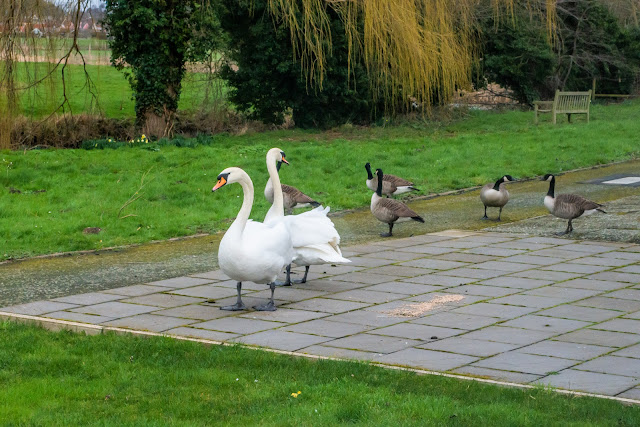Swans and their family (1)
In the early part of this year, a pair of Mute Swans settled on the river near our home. The mute swan is a very large white waterbird and has a long S-shaped neck and an orange bill with a black base and a black knob. It flies with its neck extended and regular, slow wingbeats. You certainly can`t miss it`s distinctive wing beat when they are approaching!
The population in the UK has increased recently, perhaps due to better protection of this species. The problem of lead poisoning on lowland rivers has also largely been solved by a ban on the sale of lead fishing weights. Some birds stay in their territories all year, while others move short distances and form winter flocks. In cold weather, some birds arrive from Europe into eastern England.
Over the months of February and March, we were treated to the spectacle of the swan pair and some Canada geese, arriving on our neighbours patio for feed. The swans eventually were so used to turning up for a feed, that they would, if no feed was visible, go up to the door and tap hard for attention! Swans eat aquatic vegetation, which their long necks equip them to take from the riverbed. They take the molluscs which cling to the vegetation and also eat small fish, frogs and worms but will graze big grassy fields, and can survive quite successfully in a field of short-cropped grass.
So, the pair started nest building at the beginning of March. Nest taking shape, and `just trying it out for size`. This image on 15th March.

By 21st March the first egg appeared.
..... and more building was taking place, as the water level rose a bit. Just to make it more secure I guess.
Swans appear to take it in turns to incubate the eggs and this pair were just swapping roles here. One paddled off upstream while the other ....
... settling down for an hour or two.
On 26th March I saw 4 eggs in the nest!
On 7th April there were ten! That is quite a large batch I think.
While one of the pair was sitting on the nest, the other one (obviously after some hard work) was slowly drifting downstream toward the nest. I particularly liked the reflections of the tree in the river as the swan drifted through.
So now we have to wait for the cygnets to hatch. Just 35 to 42 days to go!













Comments